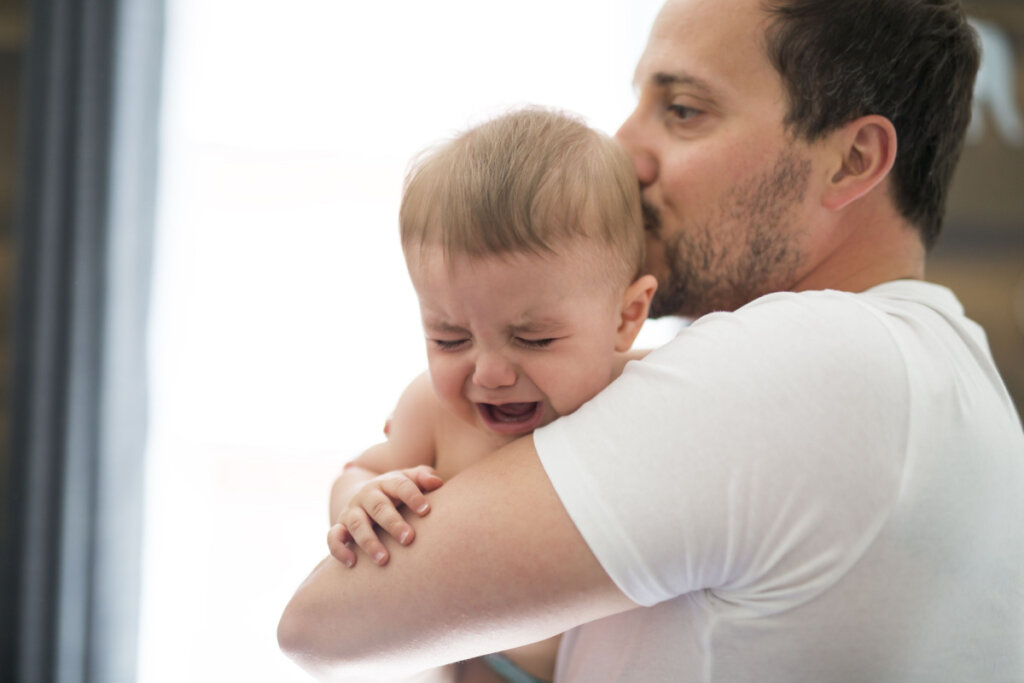How to Calm Crying Babies, According to Science


Written and verified by the psychologist Laura Ruiz Mitjana
If you have children, it’s likely that you’ve sometimes wondered how to calm their crying. In fact, seeing a child cry and not knowing why is one of the most stressful situations for any father or mother. Furthermore, not being able to calm them down generates even more anguish and upset.
A recent Japanese study, published in the journal, Current Biology, suggests a scientific formula to calm babies down and make them sleep when they’re crying.
How to calm crying babies
Science has long been concerned with the study and understanding of the human being in all its phases, including the infant stage. Within this volume of research, a really interesting study has just entered the arena that focuses its attention on the crying of babies.
This study was published in the journal, Current Biology, and conducted by the scientist, Kumi O. Kuroda and his collaborators, from the Riken Center for Brain Science (CBS) in Japan. He identified the importance of movement for calming crying infants. The research highlights the role of walking with babies in arms to calm them. In fact, it claims it’s the most effective way to calm their crying in a relatively short time.

The study
To study how to calm crying babies, the research, in which the University of Trento (Italy) also participated, included a sample of 21 babies up to seven months of age. Although it was a small sample, the rest of the methodology was solid and was a way to start studying this aspect in children. In fact, it will serve as a basis for future research.
The study was developed from 32 sessions in which infants were monitored using electrocardiograms, with the aim of measuring their heart rates. They also used video cameras to record their expressions and movements.
Four methods to calm babies down
The researchers compared four methods: walking with the babies in arms, sitting while holding them, placing them in a stationary cradle, and using a rocking cradle.
The first and last methods managed to calm them, which suggests that it’s not enough to hold the children, but that they need movement. After five minutes of walking, no baby was crying and 45 percent of them had fallen asleep.
How to calm babies
The results of the research showed that the fastest way to calm a crying baby is when the mother holds them in their arms and moves with them. In other words, they walk while carrying them. The study also determined that this should be done for a period of between five to eight minutes, after which time the babies calmed down.
However, it doesn’t only concern the cessation of crying, but this practice also helps to lower the heart rate of babies. It allows them to calm down in a shorter time, even helping them to fall asleep more easily.
The study also recommends continuing to hold babies for an equal amount of time afterward, i.e. five to eight minutes while sitting on a sofa, and not putting them to bed immediately. It means the effects of the technique are more entrenched and the baby’s sleep becomes more stable.
This technique requires a maximum time of 16 minutes in total and is highly effective. In fact, for many parents, 16 minutes is a really short time compared to the time they spend calming their babies using other strategies.

An interesting find
This study showed that, when it comes to understanding how to calm crying babies, the movement produced by walking with the baby in the arms helps calm them down and fall asleep more easily. However, interestingly, the technique was also found to be highly effective on crying infants, but not so on calm infants.
In other words, when children who cried were kept moving, they usually calmed down in a maximum time of eight minutes, after which time they usually fell asleep. Nevertheless, this technique didn’t seem to work in helping non-crying babies fall asleep.
Although the technique may not work in all cases, it’s a strategy with which positive results have been obtained. On the other hand, this and other studies currently underway could open exciting new doors for scientists who continue to study early childhood and child development.
All cited sources were thoroughly reviewed by our team to ensure their quality, reliability, currency, and validity. The bibliography of this article was considered reliable and of academic or scientific accuracy.
- American Academy of Pediatrics. (21 de marzo de 2022). How to Calm a Fussy Baby: Tips for Parents & Caregivers. Healthy Children. Consultado el 24 de agosto de 2023. https://www.healthychildren.org/English/ages-stages/baby/crying-colic/Pages/Calming-A-Fussy-Baby.aspx
- Ideran, P. & Fishbein, M. (20 de septiembre de 2021). Self-Soothing: Help Your Baby Learn This Life Skill. American Academy of Pediatrics. Consultado el 24 de agosto de 2023. https://www.healthychildren.org/English/ages-stages/baby/crying-colic/Pages/Self-Soothing-Helping-Your-Baby-Learn-This-Life-Skill.aspx
- Ohmura, N., Okuma, L., Truzzi, A., Shinozuka, K., Saito, A., Yokota, S., & Kuroda, K. O. (2022). A method to soothe and promote sleep in crying infants utilizing the transport response. Current biology, 32(20), 4521-4529. https://www.cell.com/current-biology/fulltext/S0960-9822(22)01363-X#secsectitle0020
- Mayo Clinic. (17 de diciembre de 2022). Crying baby: What to do when your newborn cries. Consultado el 24 de agosto de 2023. https://www.mayoclinic.org/healthy-lifestyle/infant-and-toddler-health/in-depth/healthy-baby/art-20043859
- MedlinePlus. (12 de octubre de 2021). Llanto en la lactancia. Consultado el 24 de agosto de 2023. https://medlineplus.gov/spanish/ency/article/002397.htm
- National Health Service. (9 de agosto 2022). Soothing a crying baby. Consultado el 24 de agosto de 2023. https://www.nhs.uk/conditions/baby/caring-for-a-newborn/soothing-a-crying-baby/
This text is provided for informational purposes only and does not replace consultation with a professional. If in doubt, consult your specialist.








